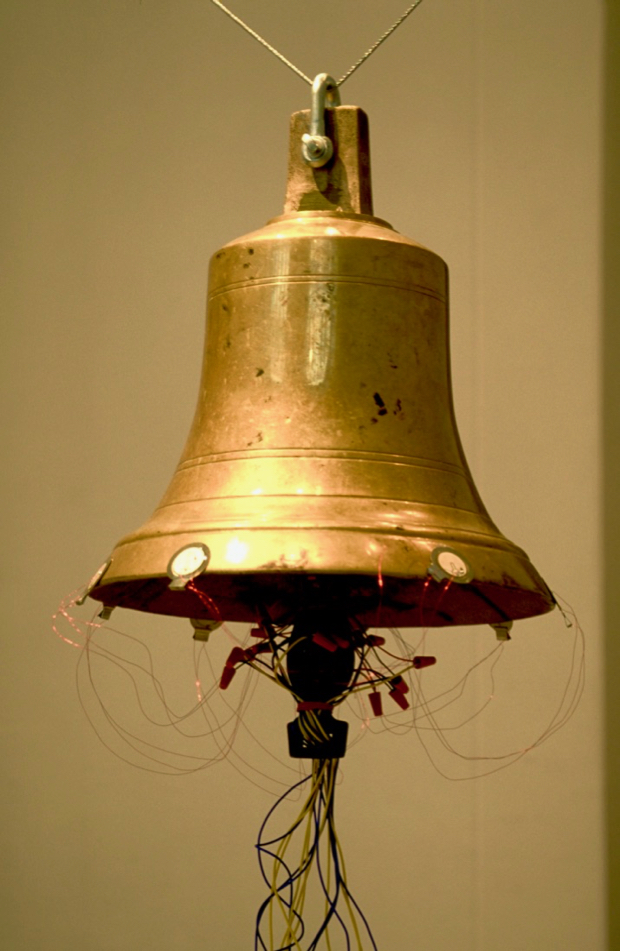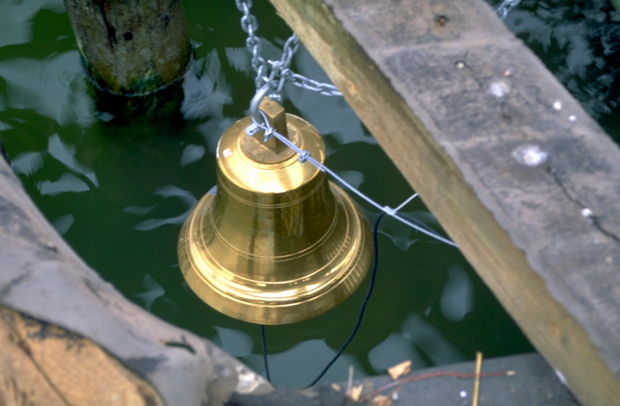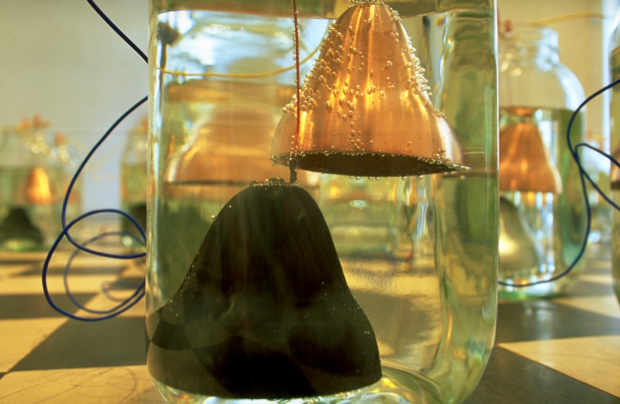A Sound-sculpture installation located in two sites.
Exhibited.
The Muu Galerie, Helsinki, Finland and at the Cholera Basin, Helsinki Harbour 1996.
Materials.
x2 Bronze Bells, x32 Voltaic cells and electronic circuits, audio equipment with ISDN telephone line. Zinc wall texts.

Dimension.
Gallery installation :- 6m x 6m, Harbour installation :- variable.
Toll.
This project was realised in the Muu Galerie, Helsinki, October 1996 as part of the “Sounds From Elsewhere” exhibition series. The work was formed by linking two sites each featuring a bell. The gallery contained a suspended bronze bell, which was excited by a series of Piezo resonators – causing it to ‘sing’ at a very high frequency. The electrical power was provided by a series of 32 Voltaic cells in the form of large glass vessels each containing two small bells, one zinc and the other copper. The second bell was located in the “Cholera Basin” of Helsinki harbour and was suspended just above the surface of the water. A microphone was installed in the place of the bell’s clapper and the sounds of the harbour environment were transmitted to the gallery via a high quality telephone link. The resulting soundscape formed in the Gallery combined the “actuality” of the Helsinki harbour, collected in the mouth of an (absent) bell – fused with the “virtual” ringing of the otherwise ‘still’ but visually present bell.

My point of departure for this work was a compact of folk-tales told of and about one of the Sussex villages where I spent a great deal of my childhood. The stories relate a narrative of a ‘virtual’ bell which has become emblematic for me – in as much as I consider all sound to be simultaneously ‘real’ and ‘virtual’, always both an event and a sign. I do not think it worthwhile to labour the point, so here is my version of the stories.

The helmsman has swept the steering oar across the ship’s stern. The bow describes a slow arc bringing the village into the wooden gaze of the dragon’s head. The hull glides between the dwarf oaks that line the saltmarsh and the crew trim the sail for landfall. At one nautical mile from shore the gaze of the figurehead is acknowledged by a clamour of bells, sounding the alarm from the octagonal tower of the church. This is all that is happening today, a fierce prow staring at ringing bells, beyond, dark, silent forests stretch over the coastal hills to nowhere.

Bell, Bellum, bellow, English resounds with memories of havoc. Every bell-rope straining in a chaotic peal, every inhabitant scrambling for the cover provided by the underground crypt, hollowed out in the sixth century by Irish Monks. But out on the marsh the Norse leader is hearing something new – a sweet harmony singing above the normal tones of the church tower – he will have this phantom bell as his prize.
This southern littoral is poor pickings – the raiders work it every four years, leaving sufficient on each occasion to allow the peasants to re-establish their livelihood. Normally the church is passed by, acknowledged as a refuge in this cycle of brutality, but this time the Norse storm the tower to take the new, sweet singing bell.
They manhandle it out of the belfry, hauling it across the water meadow and down to the hardstanding where the ship is beached. They heave its mass over the gunwhale and secure it amid-ships behind the spruce mast.

When havoc is over the crew return, pigs, sheep and chattels in tow, the ship is cast off and the prow shouldered from the hard. The oars are un-shipped and the vessel turned into the southwesterly breeze blowing from the channel, quietly now, the long-ship eases away from shore into deep water – the commander gazing happily at his bronze prize.
As the vessel reaches the dwarf oak forest once again the bell amid-ships sounds out a single tone and melts through the hull of the ship – they say that the raiders never visited again.
Many years later the villagers attempted to retrieve the bell, from its resting place, the “Bell Hole”. They employed a white witch who insisted on working with a team of pure white oxen, hauling a snow-white hair rope. The bell was located by a diver, the rope attached and the bell mostly surfaced before the rope snapped – revealing a single strand of black hair in its weave. The bell remains in its bell hole to this day.

Two hundred years after the Norse raiders first listened to the harmonics of this virtual bell king Knut laid his eight-year old daughter to rest in the crypt which had sheltered the villagers. He was ruler over the short-lived Northern Empire – and regarded by his chiefs as omnipotent.
Knut, a pragmatist, found this acclaim to be irksome and so arranged a spectacle for his chiefs in which he chose to demonstrate his fallibility. Setting a wooden throne on the very hardstanding so frequently scored by Norse keels, Knut calmly sat eying the flooding tide, commanding it, in full earnestness, to ebb. The brackish waters however would have none of it – and so Knut was eventually obliged to wade from his throne. Knut re-established his position within the hierarchy of nature, as a mere king of men. Knut’s Empire was to survive for some eighty years on Northern Europes icy fringes.